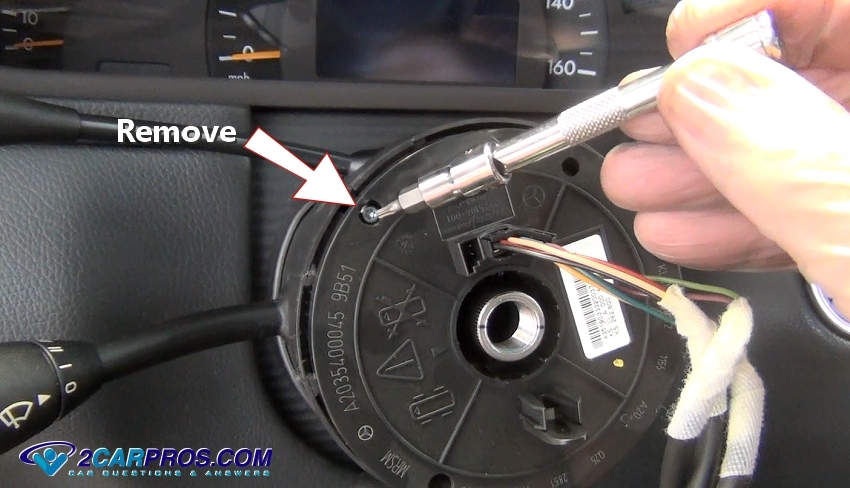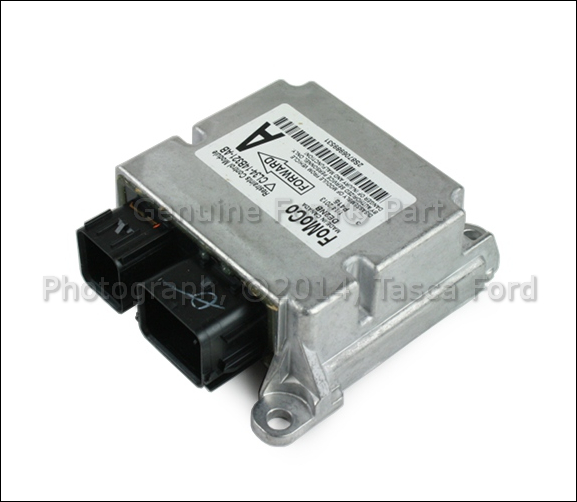
Airbag Control Module Replacement

| Crash Forensics has the equipment to download crash information for automobile Event Data Recorders (EDR). We provide complete EDR data analysis service as part of a crash reconstruction. Link to our EDR downloading and analysis expert. A modern passenger vehicle has many sensors that report all kinds of information to small computers called Electronic Control Modules (ECM). These ECMs process the sensor information and use it to make decisions about things like engine fuel management, antilock brake system activation, cruise control management, climate control management, airbag system deployment, and even speed-controlled stereo volume. These ECMs are also responsible for running diagnostics, for setting Diagnostic Fault Codes (DTC) if problems are detected, and for turning on dashboard warning lamps called Malfunction Indicator Lamps (MIL) if a fault occurs. These ECMs go by different names depending on the vehicle manufacturer, the system they control, and more than anything who is talking about them. Some examples are a Powertrain Control Module (PCM), a Body Control Module (BCM), an Engine Control Module (ECM), and an Airbag Control Module (ACM). Airbag Module - Usually Mounted Under Front Passenger Seat or Center Console Event Data Recorders Some of these ECM are storing the sensor data received by the module when an acceleration measured by the ACMs accelerometer meets a certain threshold or when an airbag deployment occurs. Since the vehicle manufacturers have not been very forthcoming about the recording capabilities of their vehicles, it is not likely that anyone other than them could say with absolute certainty what any one vehicle may or may not record. Generally however, the devices that record crash data on passenger vehicles are the ACMs and PCMs. These ECMs, when equipped with an Event Data Recorder (EDR) function, are often referred to as a 'Black Box.' Although, these ECMs are not a 'Black Box', in the true sense of the term, this descriptor helps simplify the explanation of this device. These ECMs with an EDR function historically have not provided large amounts of data recorded over long periods of time and often only provide crash acceleration data. However, some do store pre-crash data including Vehicle Speed Sensor (VSS) data for a period of five to twenty seconds before an impact. What Vehicles Have This EDR Function? It is reasonable to assume that most vehicles made since the start of this century more than likely have some ability to store crash data. However, many of the manufacturers have tried to keep this information to themselves for their own purposes. So, accessing much of the data can be problematic. What is probably more important than a comprehensive list, is a list of the vehicles that have accessible data. As of 2011, GM vehicles as old as 1994 have accessible data, Ford vehicles as old as 2001 have accessible data, Chrysler vehicles as old as 2005 have accessible data, Toyota and Lexis vehicles as old as 2006 have accessible data, as well as some Isuzu, Fiat, Mitsubishi, Scion, Sterling, and Suzuki vehicles. A regulation put in place in 2010 now prevents manufacturers from prohibiting access to this data and requires that they make equipment available to do so within six months of the production of a new vehicle. Since the list of vehicles with accessible data is rapidly changing, we have provided a link to a current list of vehicles with accessible data near the end of this page. Additionally, many large trucks have an EDR function that is based on their Engine Control Module (ECM). These ECM-based EDRs are different, and John C. Glennon, Chartered has different equipment to extract this data. Click here to find out more about large truck EDR downloads. How Are These Data Retrieved? The only tool, other than what a manufacturer may have, for downloading data from an airbag module with an EDR function is Bosh Corporation's Crash Data Retrieval System (CDR). This system acts as an interface allowing a PC to be connected to the DLC or directly to the airbag module to read the data. Event Data is downloaded in code, and the CDR software converts this code into a graphical form that can easily be read. If the vehicle's battery and wiring harness have not been damaged, the data can be extracted through the DLC with the CDR tool. If power to or communication with the ECM cannot be made due to vehicle damage, then the CDR tool can be hooked directly to the ECM. Certain precautions must be taken when powering damaged vehicles to prevent fire. Also, if the module is removed, stored data can be destroyed by improper handling. Only a qualified person should remove one of these ECMs. What Can This Data Be Used For? Crash reconstruction is the science of analyzing vehicle collisions using applied physics. A reconstruction analysis commonly relies on the study and interpretation of roadway and vehicle evidence and, when available, can also rely on the data collected from Event Data Recorders (EDRs). Data from EDRs can be very valuable evidence. However, this data is not a substitute for a crash reconstruction, but only used as evidence in a crash reconstruction analysis. A crash reconstruction may include any or all of the following: (1) the analysis of vehicle movements, (2) the analysis of vehicle speeds, (3) the analysis of vehicle impact angles, (4) the analysis of time-distance relationships of vehicles, etc. We stress that EDR data cannot stand alone, and should only be used as a tool to analyze a crash, just as any other evidence such as skidmarks and vehicle damage would be used. We often find cavalier investigators presenting this data at face value with no understanding of where the data is coming from or how the crash dynamics can affect it. However, the data must be analyzed in conjunction with other evidence to ensure its reliability. A reconstructionist must properly analyze and have an understanding of what the vehicle dynamics were prior to the collision. Then he must determine whether the vehicle's pre-crash dynamics affected the recorded vehicle speed. He must also know that the vehicle speed data comes from a vehicle speed sensor (VSS) that effectively measures the rotation of the wheels and that wheel speed and vehicle speed are not always the same. For example, a vehicle that is rolling over with its tires off the ground, or sliding sideways, or braking hard, will have a wheel speed that is different than its forward speed. These factors have to be taken into consideration to correctly analyze the data. To learn more about large truck EDR downloads, click here. To determine if you have a vehicle that has assessable EDR data click here. To find out about getting an EDR downloaded, please call us at 913-438-1038. Contact Us | Back To Top |
- V691201 Airbag Warning Lamp Illuminated in Instrument Cluster, DTC B101614 Stored in Airbag Control Module (10-12) Golf.GTI, JSW, (11-12) Jetta Sedan Keywords: V691201 Airbag Warning Lamp Illuminated in Instrument Cluster, DTC B101614 Stored in Airbag Control Module (10-12) Golf.GTI, JSW, (11-12) Jetta Sedan Created Date: 6/21/2012 10:17:50 AM.
- Audi Battery Pyro-Fuse BMW Battery Pyro-Fuse Mercedes Pyro-Fuse. You will need to replace the airbags and the SRS airbag control module in order to make the car safe to drive again. It is always best to send your original module for reset after an accident. If you purchase a new or used airbag module it may need to be programmed to your.

Airbag Control Module Removal
When found in Audi A4 (8E): Brake Electronics (Bosch 8.0) Check Coding of Powertrain Control Modules, especially check the related Airbag 9.41 Adaptation Channels 050 & 051. When found in Audi A8 (4E) Parking Brake. Resolve any faults codes in the Air Bag Module; 01321 - Control Module for Airbags (J234): No Signal/Communication Possible.
Comments are closed.